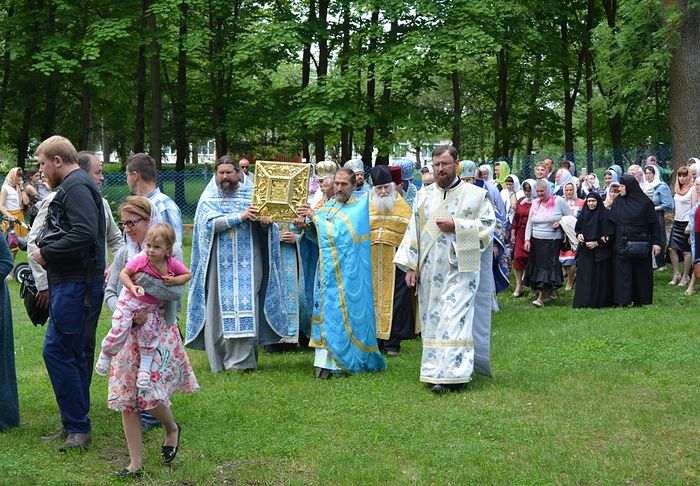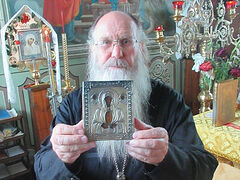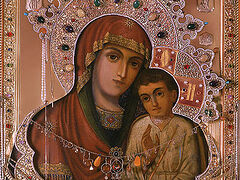 Lydia Spasskaya’s painting of the appearance of the wonderworking icon, late 1980s
Lydia Spasskaya’s painting of the appearance of the wonderworking icon, late 1980s
Some icons are wonderworking because it pleases God. The power here is not
in the icons and not in the people who have recourse to them, but in the mercy of God.
St. Theophan the Recluse
At the session of the Holy Synod of the Ukrainian Orthodox Church on December 6, 2019, the wonderworking Viliya Znamenny [“of the Sign”] Icon of the Mother of God was glorified and it was decided to establish the feast day of the icon on the Thursday before Pentecost. It was on this day, 130 years ago that the small brass icon miraculously emerged from the ground and revealed its grace-filled power. Many are interested in the history associated with this icon.
The Church of the Holy Great Martyr Paraskeva, where the wonderworking icon is kept, is located in the village of Viliya in the Ostrog District of the Rivne Province. In the “Historical and Statistical Description of Churches and Parishes of the Volyn Diocese” by N. I. Teodorovich, the year of construction of the church is listed as 1785.
The central event in the history of the church is the blessed appearance of the Znamenny Icon of the Mother of God.
 As the Viliya Icon of the Mother of God appears today
As the Viliya Icon of the Mother of God appears today
In 1889, an extraordinary phenomenon occurred in the village of Viliya. On the Thursday before the feast of Pentecost, May 25/June 6, when the Church celebrates the feast of the Third Finding of the Head of the Baptist of the Lord John, the Znamenny Icon of the Mother of God appeared in the home of the peasant Nikolai Ostapuchuk to his daughter-in-law Domna.
Over the course of 130 years, the history of this wonderworking icon has grown in many details, and a folk version of the appearance of the icon arose, which was reflected in the publications dedicated to it. However, today, based on the materials of the investigative committee of the Volyn Ecclesiastical Consistory from December 31, 1890, we have the opportunity to reproduce the real events and to get first-hand information from Domna Ostapchuk herself, whose sworn testimony is given there.
A few days before the appearance of the icon, Domna had the same dream three times. She dreamed that in her hut, in the corner by the table, lay an icon on the earthen floor. On Wednesday, as she was washing the hut inside, at noon the entire room appeared yellow and then red. The next day, the Thursday before Pentecost, when she was weeding in the garden, she heard a voice asking if she had noticed the place indicated. Arriving at the hut to feed her child, in the corner to the right of the door, under a bench, she saw some kind of light in the form of sparks, after which the earth began to rise up in this corner. She covered it with a large handkerchief. Fifteen minutes later, lifting the handkerchief, she noticed a shining icon of the Mother of God that had appeared there.
Fear and awe seized Domna, and she told her relatives, the local priest, and the villagers about the miracle. The unusual news quickly spread around the village of Viliya, and villagers began to come to the Ostapuchks’ house to see the icon. It is a small, bronze image of the Znamenny Mother of God.
Based on report No. 289 of August 27, 1889, of the dean of the fourth district of Ostrog County, Archpriest Konstantin Chervinsky, to His Eminence Alexander, vicar of Volyn, on the appearance of the icon of the Most Holy Theotokos in the home of the peasant Nikolai Ostapchuk, the Volyn Ecclesiastical Consistory, according to the determination of October 19-24, 1889, charged the local spiritual investigator under the civil official to investigate the circumstances of the icon’s appearance, described in the report of the dean Konstantin Chervinsky.
During the investigation, which lasted about a year, numerous witnesses were interviewed from among the residents of Viliya (thirty-five families are mentioned just in the investigation materials), including the village head Ivan Demyanchuk and the church warden Prochor Andruschuk, and also several priests who were at the scene of the events (Joachim Levitsky, Vladimir Ostashevsky).
Miraculous healings began to occur literally in the first days after the icon’s appearance, as recorded in the protocol.
Mikhail Feodorov Kostyuk, a sixty-two-year-old peasant from the village of Viliya, came to ask alms from the peasant Nikolai Ostapchuk on the day of the icon’s appearance. At that time, he had been suffering for more than a year from swelling of the right leg and he was covered with wounds that he couldn’t seem to heal by any means. Having learned of the appearance of the icon from Nikolai, he went with him to the room where it appeared, and Nikolai pointed him to the right corner of the hut where the icon, covered with a white handkerchief, stood on the ground under the bench. Lifting the handkerchief several times, the icon did not fall to the ground, but continued to stand. Downcast by his long illness, he began to weep bitterly and fervently pray and entreat God and the Most Holy Theotokos to send him their mercy and heal him of his wounds. After that, he often went to pray there, and every day he felt more and more relief from his illness, and finally, in the summer of 1889, his wounds completely healed. Now he feels completely healthy, which he attributes with certainty to the mercy and grace of God, received through his prayers before the icon.
The sister of the church warden, Barbara, who suffered from an eye disease, having learned about the appearance of the icon and about how many people were bringing offerings there, took the band from her hair and headed for the icon. She asked Domna to put the icon on the band and hang it back on the wall, which she did. A week later, she was healed from her eye disease.
Unusual events connected with the icon were also recorded during the investigation that convinced us of its miraculous power.
At first the icon was placed on the wall in the Ostapchuks’ home among other icons. All of the doors, windows, and other openings through which you could get into the house were closed and sealed. Security was posted by the time the commission arrived. But when the members of the commission arrived and entered the house, the icon of the Mother of God was standing on the table. This happened several times: Removing the intact and undamaged seals, entering into the house, the members of the commission found the icon of the Mother of God not on the wall, where it was placed the day before, but on the table.
Having learned of the unusual appearance of the icon, the peasant Simon Malevanchuk from Viliya brought a candle to the Ostapchuks’ home and put it there unlit. On May 26, the candle lit by itself and was extinguished by the owner in the evening.
The next day, May 27, more candles were brought which also lit by themselves while lying on the table, without damaging the tablecloth that was covering the table. The burning candles were extinguished by Nikolai Ostapchuk at nightfall, but the light that was in the room flared up after that. On May 27, the peasant Ludvig Dobrutsky brought a wax candle of his own making and put it unlit in the candlestick, and on May 28, the members of the family found it lit.
The deans were presented with written statements of people who received healing by the prayers at the icon, which were recorded in the protocol of the investigation.
Here are a few of them:
1. Susanna Ostrovskaya, a peasant woman of the village of Pivneva Gora, testified about how in 1889, as the result of a draft, she began to feel a strong pain in her arm like a paralysis. She suffered for an entire year and couldn’t control her arm, despite the means taken to relieve the pain. Having learned from others about the icon in the Viliya parish, she arrived in Viliya during Great Lent in 1890 and headed for the local church for Matins. Upon entering the church, it occurred to her to ask for the candle that happened to be with the icon. One of the brothers brought the candle, which she took with her sore arm and in a few minutes she felt so much relief that, whereas upon entering the church she couldn’t even raise her arms to put on her coat, upon returning to her apartment she could now freely move her arm and took her dress off herself without any help. And from that time, her arm became perfectly healthy, and at present she feels no pain at all. She recognizes such a sudden healing as coming from our Most Holy Lady. She is ready to confirm this testimony under oath.
2. Maria Karpyuk, a peasant from the village of Teremno, said that on June 12, 1883, she began to feel a severe pain in her right leg, like rheumatism; for seven whole years she suffered this unbearable leg pain, unable to control it. Despite various means, the pain did not subside, but increased so much that it was impossible to move around without assistance. Having learned of the appearance of the icon in the Viliya parish, she intended to pray to God there, but she couldn’t personally get there because of her illness. Therefore, in November 1889, her daughter Fevronia Feodorova Khamratovich arrived in Viliya, through whom she made an offering, and from that time her leg became healthy. And now she doesn’t feel the pain as before.
3. The peasant Sozona Tereschuka from the village of Zagorets reports that in 1888 he was very ill and couldn’t use his right arm and leg. Having learned of the appearance of the icon of the Mother of God, he turned to her with faith, offering an arm and a leg cast out of wax, after which it became somewhat easier for him, and now he can correctly cross himself and do some work.
There were also cases of punishment for blasphemy and unbelief. According to tradition, one local peasant allowed himself to blasphemously denounce the fact of the appearance of the holy icon to some pilgrims who had come from afar. At the exact same time as he was reviling the holy icon, the Lord struck him down paralyzed in the legs, arms, and face.
For several days, he lay motionless before the icon of the Mother of God, imploring the Most Pure One to have mercy upon him. Sincere prayer and repentance summoned the mercy of the Mother of God, and he rose up healthy.
The Volyn Ecclesiastical Consistory examined the materials of the investigation and on February 4, 1891, and issued a decree on the transfer of the icon to the parish Church of the Great Martyr Paraskeva.
On March 26/April 7, 1891, on the feast of the Synaxis of the Archangel Gabriel, after the moleben of thanksgiving, the icon was transferred from the home of the peasant Nikolai Ostapchuk to the church by the local dean Archpriest Konstantin Chervinsky and other clergy and a great number of people in a festive cross procession, accompanied by chanting and the ringing of the bells. The icon remains in the church to this day.
The news of the appearance of the wonderworking icon of the Mother of God in Viliya spread quickly. Not only Orthodox, but people of other confessions also came to venerate the holy icon and received grace-filled help and healing. Pilgrims walking from Kiev to Pochaev considered it a blessing to venerate the wonderworking Znamenny Icon.
Over time, the small old church could no longer accommodate the increasing number of parishioners and pilgrims, and it was decided to build a new church on the same spot. In 1900, a collection of donations for the construction of the church was announced, and an allowance of 3,000 rubles was received from the treasury. The parish priest Fr. Chrisanth Saikovich, the chanter John Kulchitsky, and the church warden Jacob Demenchuk took the most active part in the construction. The new Church of the Great Martyr Paraskeva is wooden, on a stone foundation, with two altars: the central altar dedicated to St. Paraskeva, and the right to the Znamenny Icon of the Mother of God.
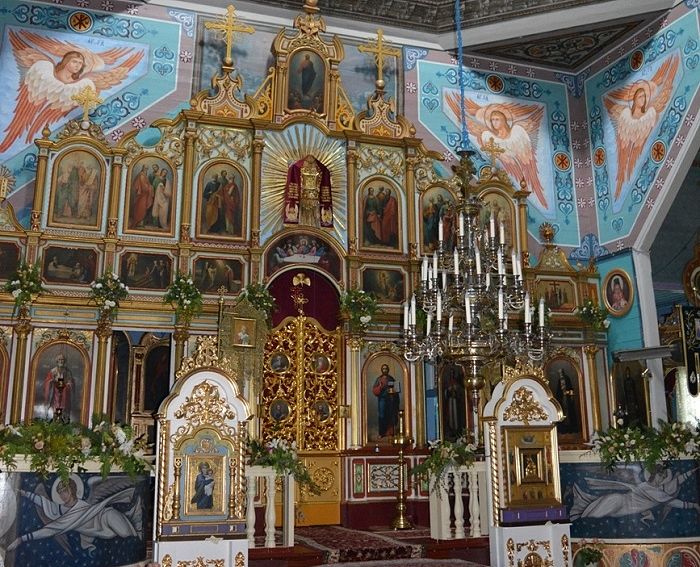 Interior of the Church of St. Paraskeva
Interior of the Church of St. Paraskeva
The Church of St. Paraskeva was consecrated by Archbishop Anthony (Khrapovitsky) of Volyn and Zhytomyr [the future primate of the Russian Orthodox Church Outside of Russia.—OC] on October 5, 1905.
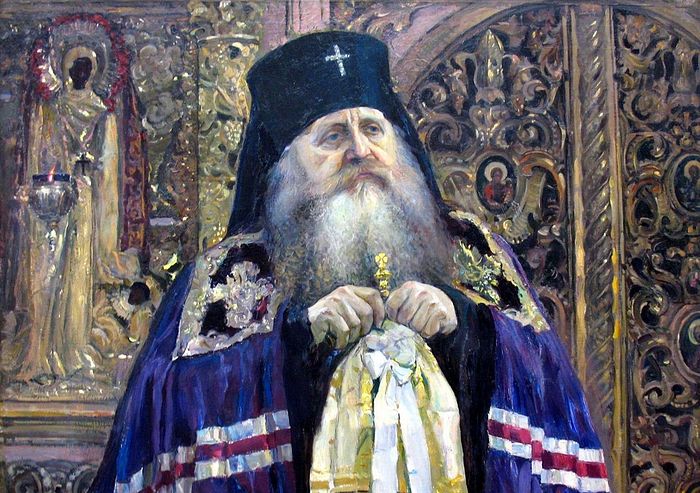 Archbishop Anthony (Khrapovitsy) by M. Nesterov, 1917
Archbishop Anthony (Khrapovitsy) by M. Nesterov, 1917
In 1906, with funds released by the Holy Synod, the church was painted and decorated by one of the best artistic and pictorial masters, Lev Ivanovich Parilov, who belonged to the famous seventeenth-century dynasty of iconographers of the village of Palekh in the Vladimir Governorate. The masters also made a metal cover for the icon that exists to this day, as evidenced by the seal on the inside of the cover. The icon is covered with a silver, gilded cover, with two angels depicted on each side holding the holy image. Above the icon is an image of God the Father. The icon is in a carved, gilded kiosk in the iconostasis above the Royal Doors.
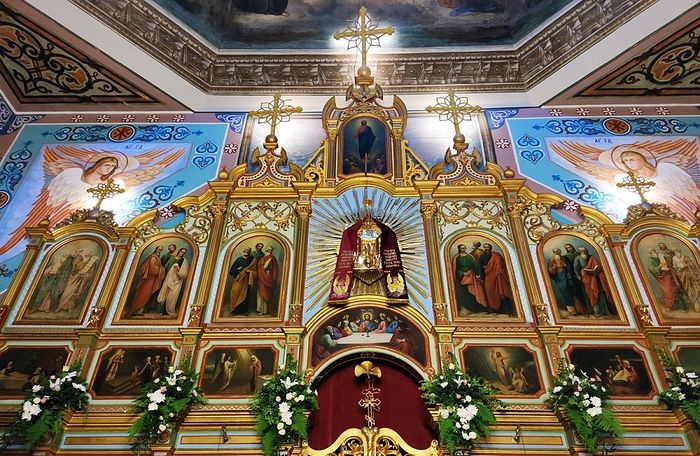 The icon above the Royal Doors
The icon above the Royal Doors
On Sundays and feast days, the icon is lowered for a moleben and for veneration. There is also a tradition of serving akathists before it.
The reception of the icon by parishioners and pilgrims, its wide popularity beyond the borders of the Ostrog District, the gracious help and miraculous healings received from the icon, as well as its official recognition by the Church as blessed and especially venerated logically should have culminated in its glorification. However, this process was delayed by further events, which Metropolitan Bartholomew of Rivne and Ostrog points out in his article dedicated to the icon: The First World War, the revolutions of 1905 to 1917, the years of Polish occupation and sovietization of Western Ukraine from 1939, etc. During the Second World War, the village of Viliya suffered several times from terrible fires, which, however, did not damage the church The villagers connect this with the icon’s protection.
After the war came a long period of atheistic pressure on the Church and parishioners. In 1965, the Church of the Great Martyr Paraskeva was closed, although it was not used for any other needs. It wasn’t converted into a club or warehouse. In the same year, the chapel built in 1928 on the site of the Ostapuchuks’ hut, where the icon appeared, was destroyed. The parishioners decided to appeal to the Moscow Patriarchate for permission to open a church. The locals Anton Demchuk and Nikolai Lischenko went to Moscow where they met with a native of Viliya, Nikolai Semenovich Kalchuk, who was the secretary and special representative of the Moscow Patriarchate at that time. Thanks to his assistance, a church was opened on August 3, 1969, and they were allowed to ring the bells. In 1990, under Fr. Alexander Kolba, the chapel was restored, where there is a copy of the icon and a painting of the famous Ukrainian artist Lydia Spasskaya showing the moment of the icon’s appearance to Domna Ostapchuk.
Every year, on the Thursday before Pentecost, after the Divine Liturgy, the clergy, parishioners, and pilgrims go in a procession with the blessed icon to the chapel on the place of its appearance and serve the festal moleben for the blessing of the waters. A good tradition has begun at the chapel of writing notes with petitions to the Mother of God for help and mercy in difficult situations, which are placed in a special box. There are very many such requests. The people’s faith in the intercession of the Most Pure Virgin never leaves them.
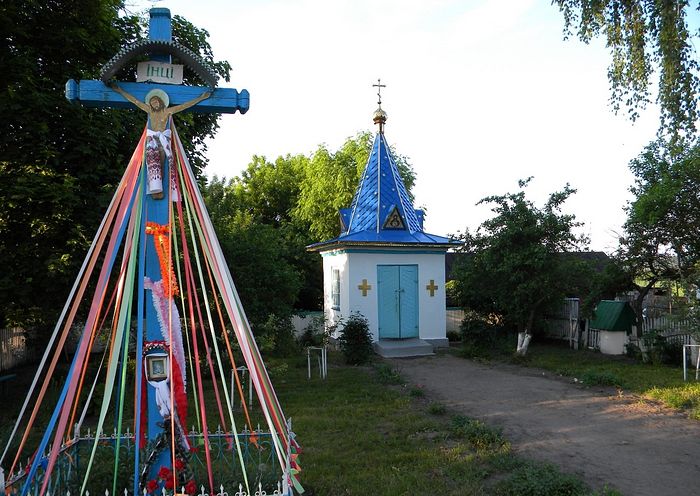 The chapel on the site of the appearance of the Viliya Icon of the Mother of God
The chapel on the site of the appearance of the Viliya Icon of the Mother of God
And today, the wonderworking icon of the Mother of God calls thousands of destitute and despondent souls, instilling faith, hope, and love in them and showing them its miraculous power.

